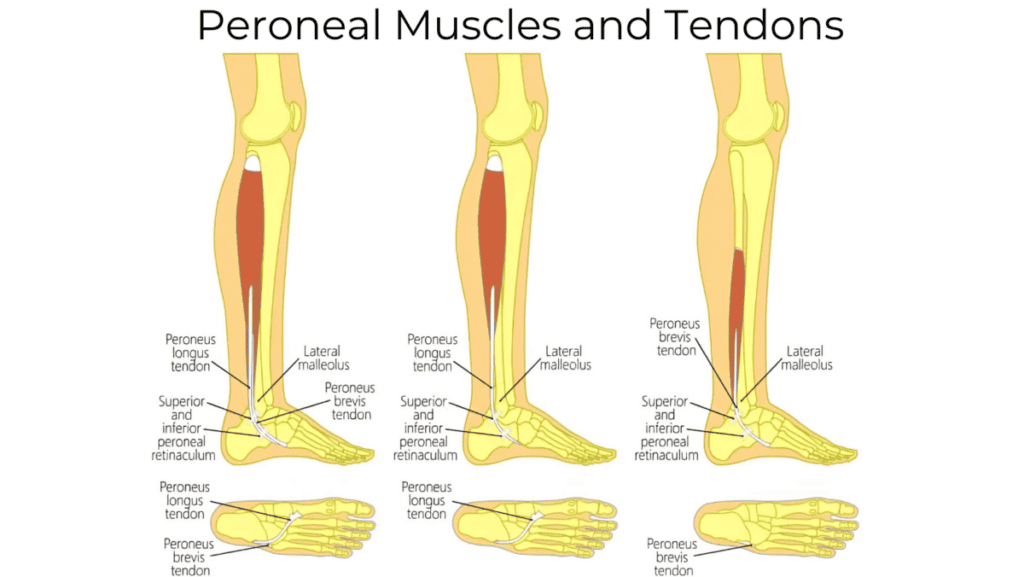Peroneal Tendonitis
- Best Asics Shoes for Flat Feet - October 25, 2024
- Best Running Shoes for Flat Feet - October 22, 2024
- Posterior Tibial Tendonitis - October 21, 2024
Understanding Peroneal Tendonitis: Causes, Symptoms, and Treatment
Hi, I’m James McCormack, a foot and ankle specialist. Today, I want to walk you through a common issue affecting the outside of the ankle: Peroneal Tendonitis (also known as Peroneal Tendinopathy). Whether you’re a runner, walker, or someone dealing with outer ankle pain, this condition can impact your day-to-day activities. Let’s break down what it is, how it happens, and what you can do about it.
What Are the Peroneal Tendons?
The Peroneal tendons run along the outside of your shin, looping behind the bony part of your ankle and attaching to your foot. These tendons are key in stabilizing your ankle and foot, especially when walking or running. They help turn your foot outward and stabilise your ankle, particularly when moving on uneven surfaces or if you roll your ankle.
What Causes Peroneal Tendonitis?
One of the most common causes of Peroneal Tendonitis is overuse. We often see this in runners who suddenly ramp up their training—whether it’s an increase in speed, distance, or intensity. Other factors can contribute too:
- Running on uneven surfaces, such as cambered roads (those with a tilt), puts more strain on the outside of your ankle.
- Shoes with thick midsoles: While cushioned shoes can be great, they may increase instability, forcing the peroneal tendons to work harder to stabilise your ankle.
- Previous ankle sprains: Repeated injuries or sprains can stretch the ligaments, making your peroneal tendons work overtime to stabilize the joint.

Symptoms of Peroneal Tendonitis
Symptoms typically develop gradually. Most people report pain on the outer side of the ankle, especially when walking or turning the foot outwards. You may also notice:
- Morning stiffness in the outer ankle.
- Pain that’s worse at the start and end of exercise, like running, but improves during the activity.
- Tenderness when touching the outside of your ankle.
- Clicking or cracking sounds as you move your ankle could indicate that the tendon is slipping out of its normal groove.
Diagnosing Peroneal Tendonitis
A physiotherapist or doctor can usually diagnose Peroneal Tendonitis with a physical exam. They might ask you to move your foot against resistance or press on specific areas to pinpoint the pain. If needed, imaging tests like an MRI or ultrasound can help rule out other issues, such as a tendon tear or ligament damage.
How to Treat Peroneal Tendonitis
The good news is that Peroneal Tendonitis generally responds well to conservative treatment, meaning surgery is rarely needed. Here’s a step-by-step guide to managing and treating this condition.
Step 1: Modify Your Activity
The first thing you’ll need to do is adjust your activity levels. Rest is important, but you don’t want to be completely inactive. Instead, reduce your activity by about 20-30% and focus on lower-impact exercises. Walking on flat surfaces or cycling can keep you moving without stressing the tendon.
Step 2: Apply Ice and Anti-Inflammatories
Applying ice to the outer ankle for 10-15 minutes a few times daily can help reduce pain and swelling. Anti-inflammatory medications, like ibuprofen, can also be helpful in the acute phase, but it’s always best to consult your doctor first.
Step 3: Strengthening Exercises
Strengthening the peroneal tendons is a crucial part of your recovery. Start with gentle band exercises to strengthen the muscles that stabilize your ankle. For example:
- Peroneal Strengthening: Sit with both feet flat on the ground. Use a resistance band to turn the foot outward, holding for a few seconds before returning to the starting position.
As your strength improves, you can gradually increase the intensity with heel raises and balance exercises. These exercises not only help the tendons heal but also prevent future injuries.
Starting a strengthening routine is crucial. Here are some exercises that can support your recovery.
Step 4: Support with Taping or Braces
In some cases, taping the ankle or using a brace can provide extra support. Taping helps offload the tendon, allowing it to rest and heal more effectively. A Peroneal Tendonitis Brace works similarly by stabilizing the ankle and reducing strain on the tendons. Learn more about how to tape your ankle in our article on Peroneal Tendonitis Taping.
Step 5: Consider Footwear and Insoles
Wearing supportive shoes is key to preventing further stress on the tendon. A low-drop shoe with a more stable base can help, as highly cushioned shoes can sometimes increase instability. In some cases, custom insoles can also help balance out your foot posture and reduce strain on the peroneal tendons. Check out our guide or tips on Peroneal Tendonitis Insoles if you want recommendations.
Step 6: Shockwave Therapy (Optional)
In some persistent cases, shockwave therapy can be considered to stimulate healing and reduce pain. While not a first-line treatment, it’s often used as an adjunct to rehab exercises and other therapies.
Recovery Time
If treated early, most cases of Peroneal Tendonitis heal within 8-12 weeks. Chronic or untreated cases may take longer, but a good rehab program can make all the difference. Sticking to your exercise routine and gradually returning to your normal activities will help speed up recovery.
Expert Advice from Flawless Physio
This content was developed by James McCormack, a specialist in lower limb health with extensive experience in managing foot and ankle conditions. If you’re facing any challenges mentioned in this article, seeking personalised advice from a qualified healthcare provider is important. James offers both online consultations and in-person assessments at his London clinic.
At Flawless Physio, we specialize in treating various foot issues, including Plantar Fasciitis, with personalized care tailored to your needs. You can book an appointment with one of our expert foot specialists at our Soho location.
Feel your best, move with confidence, and live a healthier life.
